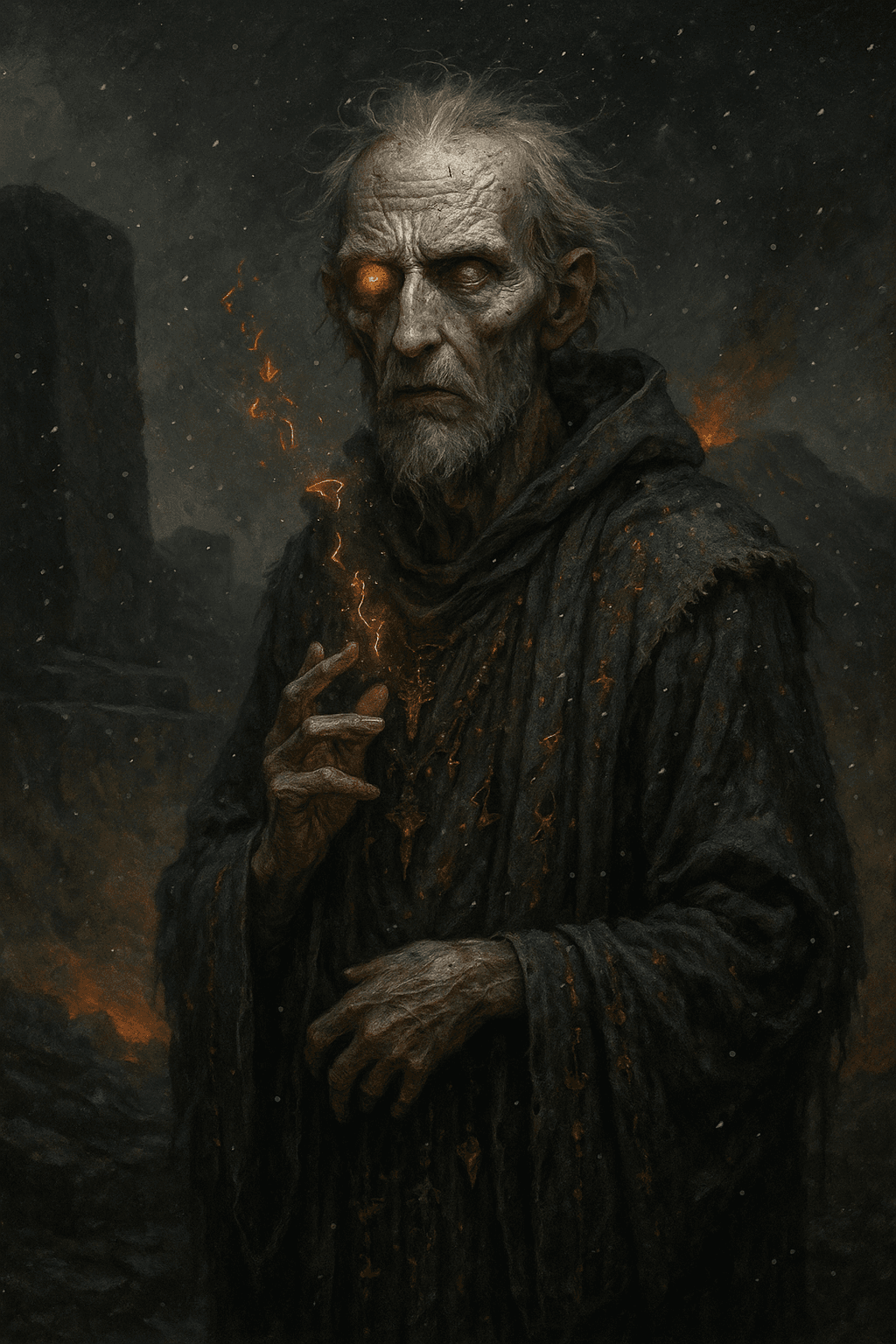Smolder-Eye
I read the dreams the fire has of us.

No one agrees on what Smolder-Eye was before the ash took him—only that since the Shattering he has worn ruin like a robe and prophecy like a fever. One eye burns with a coal that never goes out; the other stares past you into furnaces that are not yet lit. He speaks softly, as if afraid to wake the flames inside his skull.
Fracture.
When Thar Zûl erupted from the world’s broken ribs, the Choir of Ember needed omens more than armies. Smolder-Eye appeared on the lip of the Ashen Forge as if he had climbed out of the slag itself—scarred, half-blind, whispering in the grammar of sparks. He became a tool the zealous learned to hold with tongs. To the Inferna Prophet Kalzeth he promised a map inside the smoke: “Walk where the fire remembers walking.” To Ash-Priestess Vhalra he was a riddle that cut both ways; she traced circles of ward-ash around him and demanded names for the spirits that answered when he slept. He gave her none.
His trances were catastrophically useful. He would sit on a basalt step until his breath aligned with the caldera’s pulse, then mutter sequences—slagfall, wind-shear, iron-vein—and warbands would find paths across cooling rivers of rock that should have swallowed them whole. He described Magma-Drakes by scent and temperature, not by shape; handlers brought them to heel by mimicking the rhythms he hummed. But his truths were barbed. Every accurate warning carried a price: a guide burned, a bridge failed after the last soldier crossed, a captain hearing in Smolder-Eye’s voice the echo of his own death and marching like a man already falling. The Choir called him a prophet. The wiser called him a mirror: he did not invent ruin so much as let people see the ruin they wanted.
Twilight.
The Last Sky War darkened the horizon. Thar Zûl bled territory but doubled down on doctrine, and Smolder-Eye’s star rose like a coal tossed back into the brazier. The Ashen Disciple kept him close—not as a friend, but as a blade pointed the same way. “Tell me which fortresses have wooden hearts,” the Disciple would say, and Smolder-Eye would answer with a lullaby of timber and pitch and the way wind loves a canyon at dusk.
Vhalra distrusted him with ritualistic thoroughness. In the Ember Communion she tasked novices to copy his dream-glyphs, then burned the copies if they smudged. “A crooked line breeds a crooked fate,” she said, and watched the prophet through smoke the way a falcon watches a snake pretending sleep. Even Rorgak Ironjaw, who laughed at omens and preferred the certainty of a hammer, carried one of Smolder-Eye’s ash-knotted cords around his wrist after the prophet told him, “This strand is the last bridge you cross and the last breath you take.” Rorgak cut the cord after a victory. Three days later a bridge fell under him; he lived, but afterwards counted steps aloud whenever he fought.
Smolder-Eye’s predictions were rarely wrong, only disastrously right. He could tell you the hour the storm would crack or the minute a garrison’s courage would, but never whether breaking either was wise. Those who mistook his sight for leadership found themselves led by appetite. He did not object. He only watched the red light play on their faces and whispered to the coal in his head until it was satisfied.
Echoes.
The world’s tone shifted. In deep chasms beneath the Blackened Spire, miners uncovered a relic like the heart of a dead sun—the Embercore. Thar Zûl split into factions overnight: the Ashen Disciple demanding mastery, the ancient Pyre Lord insisting on purist rites. Smolder-Eye stepped sideways from the Choir just as the arguments sharpened. “I must hear the relic alone,” he said, and for once no one insisted otherwise. He walked the shattered catwalks with ash like snow in his hair, listening to the Embercore dream.
What he heard made him stranger. He began speaking of time as a kiln that bakes choice into shape. He warned the Disciple that the Embercore would teach obedience to any hand that fed it and defy any hand that gripped it. He warned the Pyre Lord that tradition was a bucket with a hole; you could pour the whole empire through it and still thirst. Both men called him oracle and liability in the same breath.
Something huge woke in the magma vaults: Cindermaws cracking cocoons of stone. One—Kindlefang—stared at Smolder-Eye the way a newborn storm stares at a mountain and did not kill him. Those who watched swore the prophet’s coal-eye flared in answer, not with command, but with recognition: two unstable flames agreeing on a secret. After that, Kindlefang prowled the edges of whatever ritual ground the prophet walked, the way lightning prowls the edges of a storm.
If Smolder-Eye has loyalties, they are not to people. They are to trajectories. He wants to decode the Embercore’s dream to its last ember, not to save anyone with what he learns. And yet—sometimes he leaves a word where it helps: a warning chalked in ash at a tunnel mouth, a line of cinder-marks across a brittle catwalk that keeps a child from stepping through. It is possible he remembers being human. It is possible he never was.
Ask him, and he will smile like a man enjoying a private joke. “We are all tinder,” he says. “I only volunteer to be first.”
